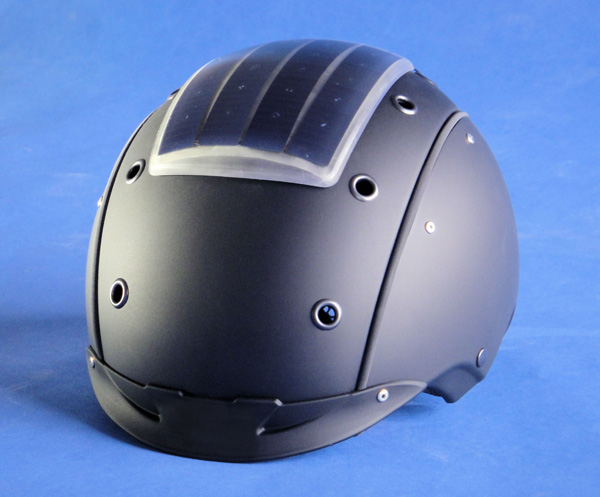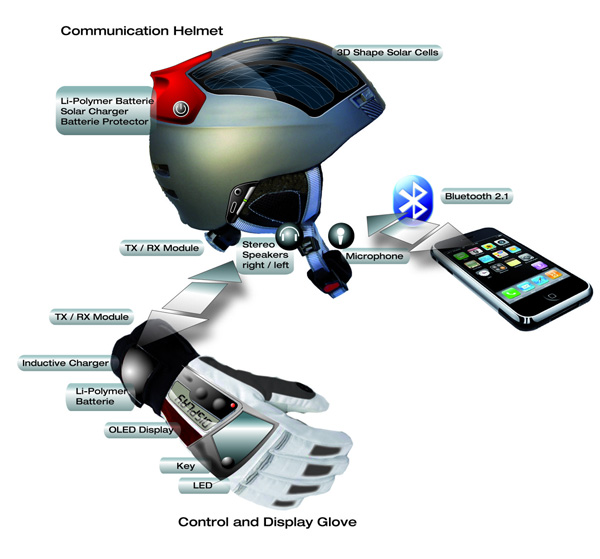Sun Power Helmet
Researchers from the Fraunhofer IZM Institute (Germany) have developed a three-dimensional solar module that is installed on a ski helmet. Using the method invented by scientists for the first time, it was possible to reliably and almost imperceptibly fit powerful solar cells onto the curved surface of the helmet.
For the most complete energy supply, an integrated communication module is placed directly into the helmet: a stereo headset or headset works with the help of energy generated through solar cells on the surface of the helmet. It is quite possible to wirelessly connect a mobile device, such as a smartphone or MP3 player. With the help of Bluetooth installed on the glove, the user gets direct access to incoming calls, while he doesn’t need to take off the gloves themselves in the cold.
The user receives such a communication system, which is entirely integrated into the ski equipment without burdensome wires and almost without additional gravity.

')
The headset is directly powered by a newly invented solar module. This contributes to a full supply of energy in all weather conditions, however, only if extensive solar cells with very high efficiency (> 20%) are used.
The greatest difficulty for scientists was the optimal fit of the module to the uneven, curved surfaces of the helmet. Until now, this was possible only when very small solar modules were embedded on such a difficult surface.

To solve the problem, the institute-developer has introduced a new technology, in which high-performance solar cells made of monocrystalline silicon are segmented into small chips, so they can also be used on a three-dimensional, curved shape. The risk of breakage of an individual element under local mechanical load is therefore also greatly reduced. And due to the redundant design of solar cells, the flawless operation of the entire system is guaranteed, even if a separate element is damaged.
As the developments show, this very reliable technology can be applied not only to optimize the downhill skier's communication. A power unit made in the form of a compact device can be easily adapted to other curved surfaces, such as backpacks, clothing parts, body parts, as well as motorcycle and bicycle helmets, lifeguard helmets, etc.
It is convenient to integrate a module with a nominal power of 2 W into a conventional helmet, which corresponds to the power consumption of the same smartphone.
Low temperatures or sudden temperature changes in the places of use of the device should be especially taken into account, because when operating solar cells at low temperatures, battery life is significantly reduced. At temperatures below 0 ° C, charging the battery is also ineffective or not at all possible. Using an integrated communication module without interruption is possible with a full supply of energy produced directly by the solar panel with sufficient light.
In addition, in the period of non-use of the helmet, you can safely charge your smartphone or MP3 player directly from the battery. Search sockets, say the developers, is gone. The rate of today is the use of solar energy while preserving the environment.
At present, the public is presented with a prototype of a helmet using the energy of the Sun, while scientists are still busy with field tests of the device and its redesign. It was promised that such helmets would be introduced to the market by one of the leading manufacturers of this element of ski equipment at the end of this year, and the retail price would be about 300 euros.
Read more about the project at the source site: www.izm.fraunhofer.de/de/news_events/tech_news/solarhelm_liefertstromaufderskipiste.html
For the most complete energy supply, an integrated communication module is placed directly into the helmet: a stereo headset or headset works with the help of energy generated through solar cells on the surface of the helmet. It is quite possible to wirelessly connect a mobile device, such as a smartphone or MP3 player. With the help of Bluetooth installed on the glove, the user gets direct access to incoming calls, while he doesn’t need to take off the gloves themselves in the cold.
The user receives such a communication system, which is entirely integrated into the ski equipment without burdensome wires and almost without additional gravity.

How it works?
')
The headset is directly powered by a newly invented solar module. This contributes to a full supply of energy in all weather conditions, however, only if extensive solar cells with very high efficiency (> 20%) are used.
The greatest difficulty for scientists was the optimal fit of the module to the uneven, curved surfaces of the helmet. Until now, this was possible only when very small solar modules were embedded on such a difficult surface.

To solve the problem, the institute-developer has introduced a new technology, in which high-performance solar cells made of monocrystalline silicon are segmented into small chips, so they can also be used on a three-dimensional, curved shape. The risk of breakage of an individual element under local mechanical load is therefore also greatly reduced. And due to the redundant design of solar cells, the flawless operation of the entire system is guaranteed, even if a separate element is damaged.
Possible uses
As the developments show, this very reliable technology can be applied not only to optimize the downhill skier's communication. A power unit made in the form of a compact device can be easily adapted to other curved surfaces, such as backpacks, clothing parts, body parts, as well as motorcycle and bicycle helmets, lifeguard helmets, etc.
It is convenient to integrate a module with a nominal power of 2 W into a conventional helmet, which corresponds to the power consumption of the same smartphone.
There are drawbacks
Low temperatures or sudden temperature changes in the places of use of the device should be especially taken into account, because when operating solar cells at low temperatures, battery life is significantly reduced. At temperatures below 0 ° C, charging the battery is also ineffective or not at all possible. Using an integrated communication module without interruption is possible with a full supply of energy produced directly by the solar panel with sufficient light.
In addition, in the period of non-use of the helmet, you can safely charge your smartphone or MP3 player directly from the battery. Search sockets, say the developers, is gone. The rate of today is the use of solar energy while preserving the environment.
When to market?
At present, the public is presented with a prototype of a helmet using the energy of the Sun, while scientists are still busy with field tests of the device and its redesign. It was promised that such helmets would be introduced to the market by one of the leading manufacturers of this element of ski equipment at the end of this year, and the retail price would be about 300 euros.
Read more about the project at the source site: www.izm.fraunhofer.de/de/news_events/tech_news/solarhelm_liefertstromaufderskipiste.html
Source: https://habr.com/ru/post/150223/
All Articles